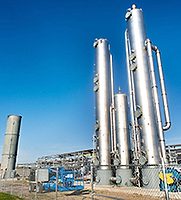South Sioux City Officials Blame Sewer Odor Problems on Plumbing

As many as 26 households in South Sioux City, Neb. were displaced and living in hotels for several months due to sewer gas that city officials now blame on inadequate plumbing and not a nearby energy facility.
In late October, city officials originally tied Big Ox Energy and its renewable energy plant, which converts organic waste into methane gas, to hydrogen sulfide gas believed to be emanating from a sewer line that more than 30 homes shared with Big Ox and other businesses in the city's Roth Industrial Park.
The plant went online last September with nearby homeowners in a five-block area quickly complaining about the smell.
This month, however, city officials concluded that the residential sewer lines in question are separated from the industry waste force main with no cross connection. Instead, the city blamed faulty plumbing or inadequate plumbing maintenance.
That puts the city squarely in agreement with Big Ox, a Denmark, Wisconsin-based company, that released a report last month asserting that below-code plumbing in dozens of homes was the culprit and not wastewater from the company’s plant.
The report prepared by Black & Veatch, a Kansas City-based engineering firm Big Ox hired, indicated that most of the homes that reported sewer odors either had inadequate or broken residential plumbing systems or were residential units that shared a wall with other units that had failed the test.
The report said hydrogen sulfide gas is common in sewer systems and can be produced by a variety of industries similar to those existing in South Sioux City. However, if a home's plumbing protections, such as traps and vents, are up to code, hydrogen sulfide should not intrude into residences, regardless of the level of the gas.
Of the 66 homes in the neighborhood associated with the odors, 35 reported an odor while 31 reported no odor, according to the report. Of 32 homes that agreed to be tested, 26 failed plumbing tests, the report said. Three affected homeowners refused to have their homes tested.
Of the six homes that reported odors but passed plumbing tests, three were multi-unit buildings that shared a common interior wall with units that had failed plumbing tests. The other three, the report suggested, may have addressed the faulty plumbing at the city's recommendation prior to the inspection.
Of the homes that did not report odors but still requested plumbing tests, all passed but one, according to the report. Kevin Bradley, Big Ox's director of business and economic development, said the deficiency for that home was found in the attic of the house and that any odor likely escaped without the residents' knowledge.
The report also points to readings in the sewer lines that showed spikes in gas levels even after Big Ox went offline as evidence that the renewable fuels plant was not conclusively the main source of the high levels in the sewer.
Test results have shown hydrogen sulfide gas is now within safe levels established by the state of Nebraska. Meanwhile, a firm hired by South Sioux City began testing recently for other sulfur-related compounds in the homes that could be causing continued odors.
As of Feb. 14, the costs of temporary housing that had been financed by the city and Big Ox ceased. Legal action still continues.
More details here.
Source: Sioux City Journal




